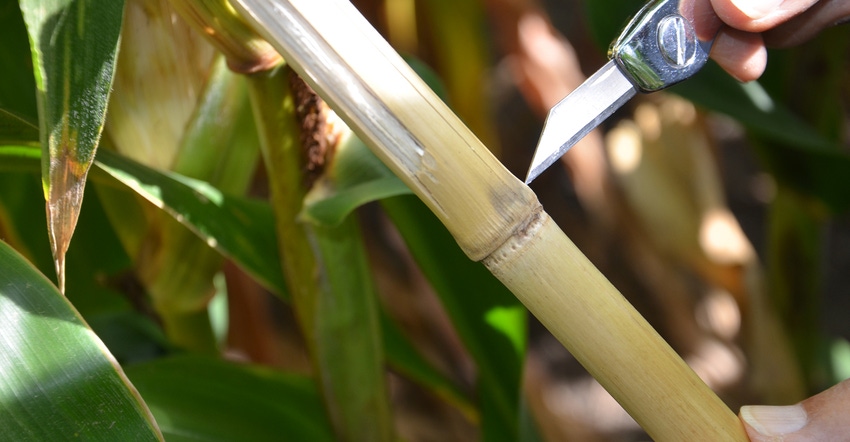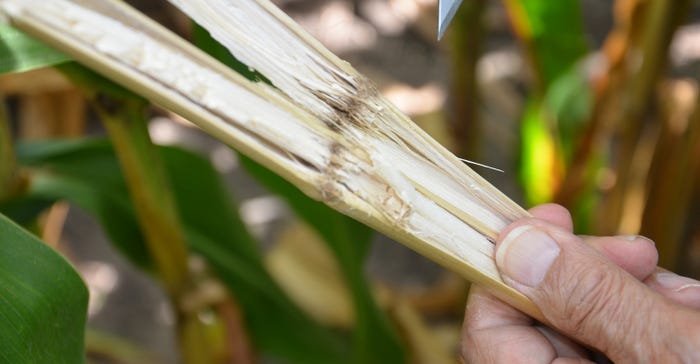
Here’s the scenario that the Corn Watch ’19 field endured this year. Due to a super-wet spring, it was planted May 28. Conditions stayed on the cool, wet side, with more than 5 inches of rain falling over 10 days, from June 15 through June 25.
Despite the late start and wet soils, most of the field progressed nicely. “Then hotter, drier weather occurred in late June and early July, and again in late August through September,” Dave Nanda says. Nanda is director of seed genetics for Seed Genetics-Direct, Jeffersonville, Ohio. Seed Genetics-Direct sponsors Corn Watch ’19. A break with favorable weather occurred during pollination and early grain fill.
Good early growth, even if planting date was delayed, followed by dry stretches severe enough to cause cracks in the ground, can set corn plants up for stalk rot, Nanda says. He found stalk rot in the field around Oct. 1, even before either of the two hybrids planted in the field reached black layer. Fortunately, stalk rot was just beginning to show up and wasn’t a big problem yet.
Some fields in southern Illinois, Indiana and Ohio weren’t as lucky. Where drought started earlier and was more extreme, and where corn was planted even later, some fields or parts of fields died early. Ear size and kernel depth were affected, and stalk rots appeared in some fields.
Identify and plan
“Stress is a major factor in bringing on stalk rots,” Nanda explains. “There are several different types, all caused by fungi. Anthracnose is one of the most common.”
Nanda demonstrated how to look for anthracnose stalk rot on a stalk he found in the Corn Watch ’19 field. Although the stalk was drying up while neighboring plants still had green tissue, anthracnose appeared to be in the early stages.
“I found black discoloration at a node on the outside,” Nanda says. “When I cut the stalk open, there was black discoloration of the pith at that same node. As anthracnose gets worse, there will be many more black spots on the outside, resembling shoe polish. The inside of the stalk breaks down and can get very dark.”

PROOF INSIDE: Here is the same stalk as shown above once Dave Nanda split it open. Notice the pith tissue inside around the node is dark in color.

Once you find stalk rot, there’s nothing you can do for the current crop, except determine how many plants are infected. Nanda uses a push test, walking down between two rows and pushing on 100 plants in each row. Plants that don’t bounce back are likely infected. He averages the numbers together. For example, if an average of 10 plants out of 100 don’t bounce back, 10% of plants are already infected. You would likely mark that field for early harvest.
Knowledge that there is stalk rot in the field, and preferably which stalk rot, helps in future planning. You can select for hybrids with more resistance. You can also tweak your management system to minimize chances for nutrient deficiencies and overcrowding. These are other causes of stress, Nanda concludes.
About the Author(s)
You May Also Like




